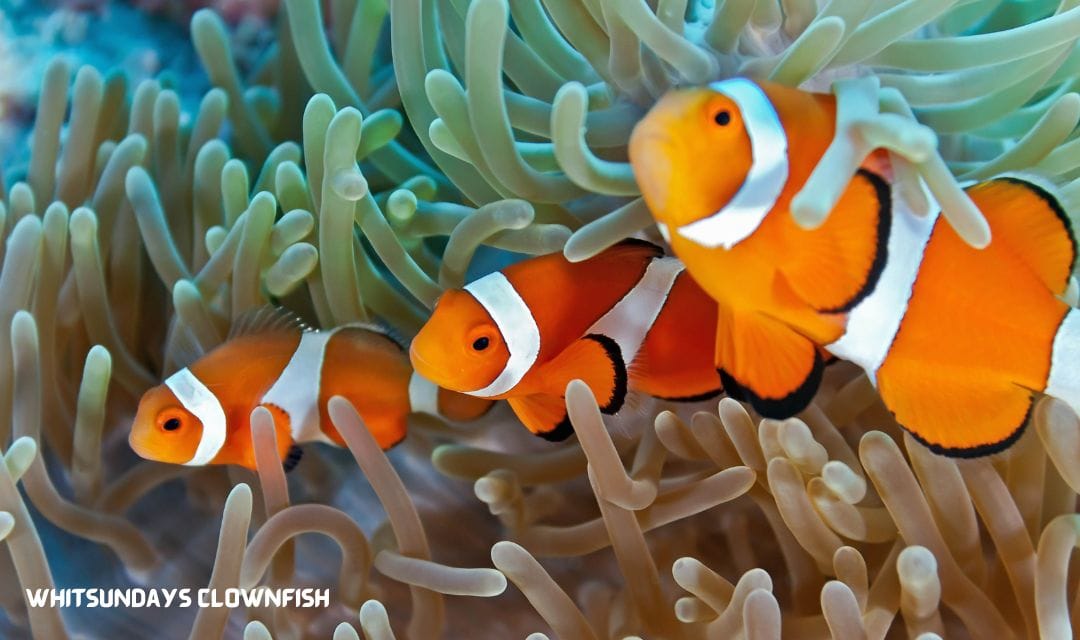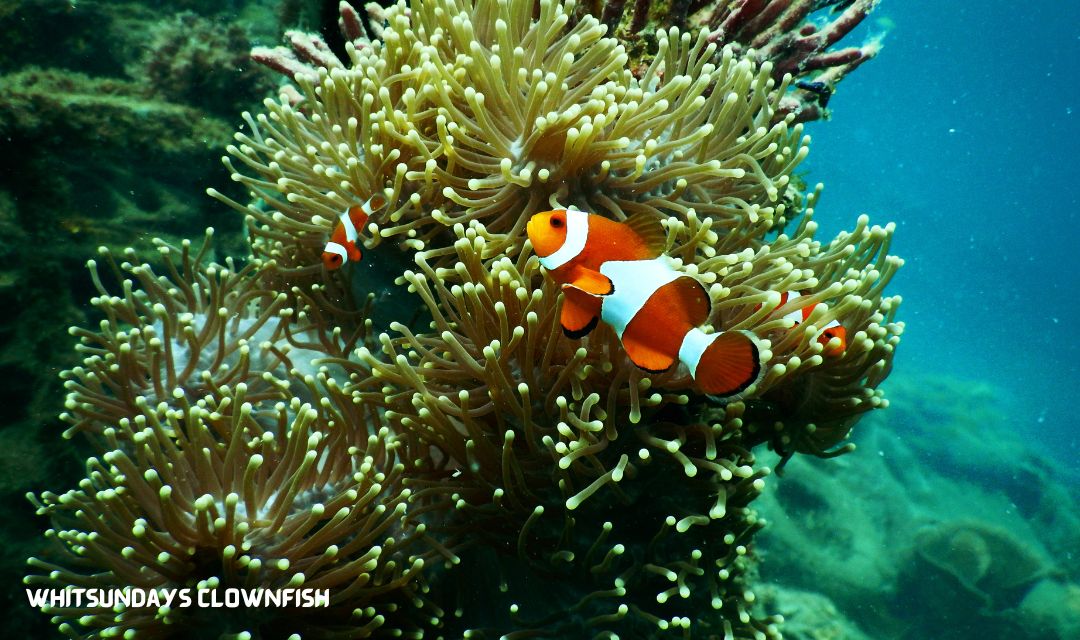Clownfish In The Whitsundays
Yes, you can see clownfish in the Whitsundays! These bright-coloured fish shot to fame with the movie Nemo, and now they are still one of the most asked-about fish on tours and activities. Here is everything you need to know about clownfish and where to find them in the Whitsunday Islands.

Clownfish Habitat and Diet
Warm Waters and Sheltered Reefs
Clownfish thrive in warm waters like the Great Barrier Reef and Whitsunday Islands. They are particularly abundant in sheltered reefs and lagoons, inhabiting sea anemones. This relationship provides these small, vibrant fish with a safe haven and food source. The Great Barrier Reef is a prime location for spotting these fascinating creatures, making it a popular spot for tourists and researchers.
Diet and Feeding Habits
Clownfish have a varied diet that includes small invertebrates, algae, and leftover food particles from their anemone hosts. The symbiotic relationship is mutually beneficial, as the anemone offers protection and food scraps while the clownfish lures prey into the anemone’s tentacles.
Clownfish in the Whitsundays
Prime Locations for Clownfish
The Whitsundays are part of the Great Barrier Reef Marine Park and provide ideal conditions for clownfish. Popular sites within this region include shallow coral bays and reef slopes where these fish are commonly found. The warm, shallow waters teem with marine life, making them accessible to snorkellers and divers who wish to see clownfish in their natural habitat.
Most Whitsunday tours that offer snorkelling as a ticket option will take you to Coral reefs with clownfish. The crew will be able to tell you their exact locations on the reef.
Symbiotic Relationship
Mutually Beneficial Bond
The symbiotic relationship between the clownfish and the anemone is one of the most fascinating aspects of marine biology. The anemones, with their venomous tentacles, protect the clownfish from predators and provide food scraps. In return, the clownfish attracts potential prey to the anemone and fertilizes it with its waste, promoting its health and longevity.
Role in Ecosystem
This relationship benefits the clownfish and anemone and maintains the ecological balance within their habitat. By attracting prey to the anemone, clownfish in the Whitsundays contribute to the local food web and help sustain the reef’s biodiversity.

Clownfish Reproduction
Social Structure and Communication
Clownfish live in groups dominated by a single female, a dominant male, and a group of smaller males. These fish communicate through popping and clicking sounds. If the female dies, the dominant male turns into a female, and the largest of the smaller males becomes the new dominant male—a fascinating process that ensures the continuity of the group.
Egg Laying and Care
Female clownfish can lay thousands of eggs, which the male fertilizes. The male then diligently guards the eggs, ensuring they are clean and protected from predators. The male eats damaged or infertile eggs to maintain the brood’s health.
Threats to Clownfish
Overfishing and Trade
Although clownfish are not currently endangered, their populations have been affected by overfishing and the marine ornamental trade. Clownfish constitute 43% of the global ornamental fish trade, with 75% captured from the wild. This exploitation has led to reduced population densities in certain areas, highlighting the need for responsible practices and conservation efforts.
Conservation Status
Whitsundays Clownfish FAQ
What are the primary habitats of clownfish?
Clownfish primarily inhabit warm waters, such as those in the Great Barrier Reef and Whitsunday Islands. They are often found in sheltered reefs or lagoons, living symbiotically with sea anemones.
How do clownfish reproduce?
Clownfish reproduction involves a complex social structure where all fish are born male, and the dominant male can turn into a female if the current female dies. Females lay thousands of eggs, which the male fertilizes and guards until they hatch.
What role do clownfish play in their ecosystem?
Clownfish contribute to the ecological balance of their habitat by maintaining a symbiotic relationship with sea anemones. They lure prey to the anemones and provide nutrients through their waste, promoting the health of the anemones and supporting local biodiversity.
Check Out All The Tours
Looking to visit Whitehaven Beach or the Great Barrier Reef, see all the tours.
More Great Barrier Reef Information
Get in Touch
Have Questions?
Ask Nath J
74 Whitsunday Islands 1 Whitehaven Beach
Hi, I’m Nath J, a long-time local who’s been lucky enough to live and work tourism in the Whitsundays since 2001.
Over the past two decades, I’ve helped visitors discover the best of this incredible region, from Whitehaven Beach and Hill Inlet to the hidden spots only locals know about. I started out managing boats and tours, and these days I run Ripple Effect Online, a tourism-focused digital marketing business helping local operators grow and connect with travellers like you.
I’ve written an ebook called Whitsunday Islands: A Journey through Paradise, created countless local travel guides, and earned recognition as a “Whitsundays Tourism Hero” from QTIC for my contribution to the region and gained First Nations Cultural Protocol training through QTIC as well. But more importantly, I’ve spent years listening to travellers, understanding what makes a trip unforgettable, and helping people plan the kind of experience they’ll talk about for years.
If you’re planning a visit to Whitehaven Beach or anywhere in the Whitsundays, I’m here to help you make it amazing.
Find me on Facebook and LinkedIn or drop me an email at info@nath-j.au.
